Welcome to Sandy Bridge, with the ASRock P67 Extreme4
by Ian Cutress on January 3, 2011 7:00 AM EST- Posted in
- Motherboards
- ASRock
System Benchmarks
CrystalDiskMark 3.0.1
We test the motherboard's USB 2.0 and USB 3.0 speed via CrystalDiskMark. We run the sequential test to find the optimum read/write speed, then perform a copy from the SSD to the USB device. We copy a set of 2867 files across 320 folders—95% of these files are small typical website files, and the rest (90% of the size) are the videos used in the Sorenson Squeeze test. Total size is 1.52GB
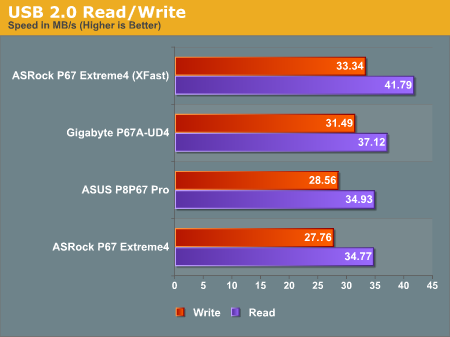
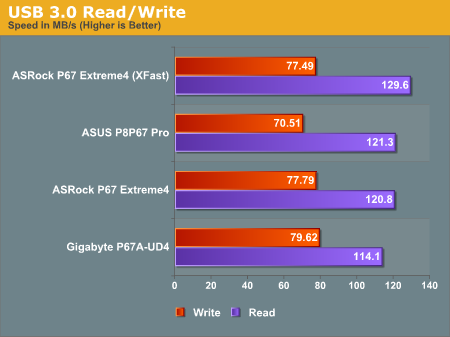

We also tested the ASRock XFast USB software. While making a slight difference to the sequential read/write speeds, it actually makes a difference in real-world situations where large amounts of small files need to be copied. USB 3.0 didn't benefit as much as USB 2.0, and it's worth noting that without XFast the USB 2.0 speed was the slowest of the three motherboards, but it does provide a benefit and turns the Extreme4 into the fastest overall USB choice.
3D Movement Algorithm Test
This benchmark is actually one I have written. My full time job involves computational chemistry, so this first benchmark uses various algorithms for three-dimensional simulation and movement of independent particles. The algorithms either employ uniform random number generation or normal distribution random number generation (with periods exceeding 2^120), and vary in various amounts of trigonometric operations, conditional statements, generation and rejection, fused operations, etc. The benchmark runs through six algorithms for a specified number of particles and steps, and calculates the speed of each algorithm, then sums them all for a final score. This is an example of a real world situation that a computational scientist may find themselves in, rather than a pure synthetic benchmark. The benchmark is also parallel between particles simulated, and we test the single thread performance as well as the multi-threaded performance.

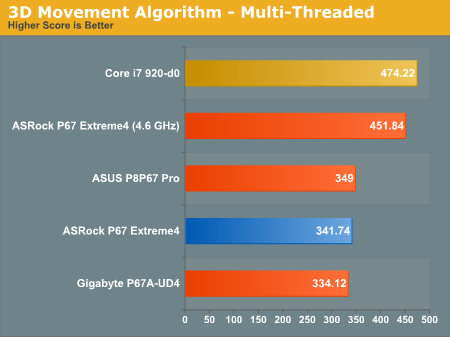
As expected, the single thread performance with the Sandy Bridge processor over the i7-920. This is in part due to the difference in speed in single-thread mode, but also to the increased logic on the Sandy Bridge processor. In the multi-threaded test, it's a case of available threads - the i5-2500K has 4 cores/4 threads available, whereas the i7-920 has 4 cores/8 threads available. In both tests, the ASRock performs well, being beaten (just) by the P8P67 Pro.
With 64-bit WinRAR, we compress a set of 2867 files across 320 folders—95% of these files are small typical website files, and the rest (90% of the size) are the videos used in the Sorenson Squeeze test. Total size is 1.52GB. WinRAR x64 3.93 attempts to use multithreading when possible.
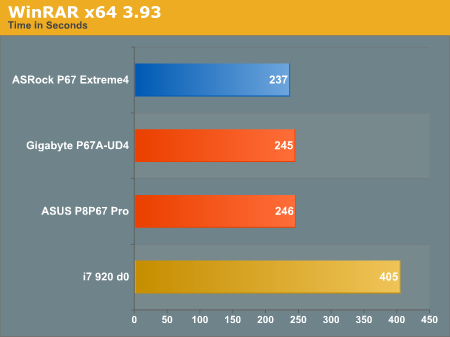
FastStone Image Viewer 4.2
FastStone Image Viewer is a free piece of software I have been using for quite a few years now. It allows quick viewing of flat images, as well as resizing, changing color depth, adding simple text or simple filters. It also has a bulk image conversion tool, which we use here. The software currently operates only in single-threaded mode, which should change in later versions of the software. For this test, we convert a series of 170 files, of various resolutions, dimensions and types (of a total size of 163MB), all to the .gif format of 640x480 dimensions.
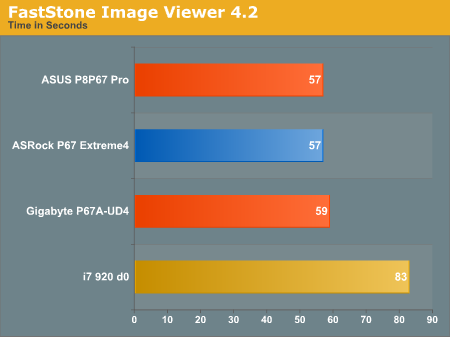
Sorenson Squeeze 6.0
Sorenson Squeeze is a professional video encoder, complete and rife with options. For this test, we convert 33 HD videos, each a minute long and approximately 42 MB in size, to WMV 512KBps format. Squeeze can encode multiple videos at once, one for each thread.
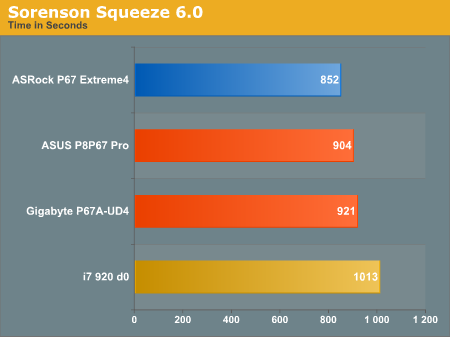
Overview
The ASRock board has relatively mediocre USB speeds, until XFast is used. In general, this board does fairly well across the entire 2D benchmark suite, either being at the top or near the top.










55 Comments
View All Comments
zipzoomflyhigh - Tuesday, January 4, 2011 - link
1 yr warranty? REally?regginGUY - Wednesday, January 5, 2011 - link
Please explain why this motherboard did so much worse than the others. Something doesn't add up.IanCutress - Saturday, January 8, 2011 - link
That board didn't fair as badly as you claim. In the system benchmarks, it performs very well, and in the 3D benchmarks it's slightly worse than the ASRock in single card (as does the Gigabyte) but performs very admirably in dual card.Don't forget, each benchmark has a statistical variation on it, so the results could easily be +/- a certain amount, depending on the consistency of the benchmark. You'll never get the same score on 100 consecutive runs unless the benchmark is written so that the cache management is pre-optimised before every run (which a few synthetics do).
The 3D benchmarks are representative a typical game. For example, a lap on Dirt2 with a lot of action will have a lower framerate than one where you spend all the time out in front. The benchmark in Dirt2 does a bit of both, by starting the car at the back of the grid, performs some overtakes, and sometimes gets easily overtaken, representing an average lap.
Ian
IanCutress - Monday, January 10, 2011 - link
I've actually come across the problem now through my own testing. It turns out that Dirt 2 has an issue on how you do single card mode. If there is two GPUs in the system and you disable one in Catalyst, you get an FPS drop compared to running the benchmark with just one GPU in the system. This issue doesn't affect Metro 2033 in our benchmark suite, thus I'd have to conclude it's an issue with the Dirt 2 engine with AMD Catalyst.The new FPS figures for the ASUS and Gigabyte boards will be updated shortly. Full reviews of these boards will hopefully go up in the next couple of weeks.
Ian
oxyurus - Saturday, January 8, 2011 - link
Should have mentioned the x8/x8 pci 2.0 mode, as most of the boards at this price range are 16x/x4.Mephi5to - Sunday, January 9, 2011 - link
Take a look at the picture of the mobo - bottom left corner. PATA connector =/= IDE?Mephi5to - Sunday, January 9, 2011 - link
Nevermind :) I was so confused that actually went to their site and DL'd manual. It's a floppy connector. Sorry peeps.Shube - Monday, January 24, 2011 - link
The specs for this board show 32Gb max memory space using unbuffered DDR3. With 4 slots that means 8Gb memory sticks. I can't find any available. Does anyone have any idea when they will be available? At what speed? Any details appreciated!marraco - Sunday, January 30, 2011 - link
What about UEFI supposedly enhanced boot times?katleo123 - Tuesday, February 1, 2011 - link
good informative post about sandy bridgefor more info visit http://www.techreign.com/2010/12/intels-sandy-brid...